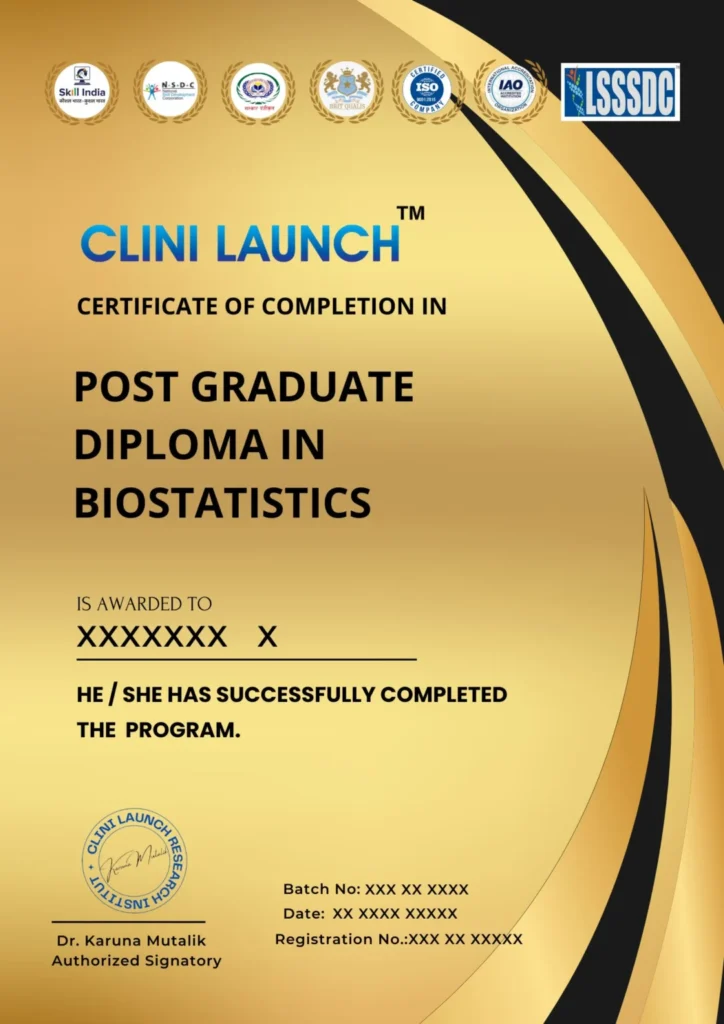Biostatistics Course
- 100% Placement Assistance
- Industry-led Expert Training
- Comprehensive Curriculum
- Globally Recognized Certification
Healthcare Diploma Courses for Pharma & IT Professionals
Live Online Classes starting on 8th, 15th, 22nd & 30th.
Book Your Free Demo Class Today!
Biostatistics Course
Dive into the world of Biostatistics and learn how to find valuable insights from health and biological data. This course equips you with the statistical tools and methods essential for designing studies, analyzing complex medical research, and drawing meaningful conclusions in public health and clinical settings.
- 100% Placement Assistance
- Industry-led Expert Training
- Comprehensive Curriculum
- Globally Recognized Certification
Get essential concepts for data collection, analysis, and interpretation covered to help you prepare for biostatistics career in healthcare.
Live Online Classes starting on 8th, 15th, 22nd & 30th.
Book Your Free Demo Class Today!

IAO & NSDC Accredited Courses

IAO & NSDC Accredited Courses

IAO & NSDC Accredited Courses

IAO & NSDC Accredited Courses
PG Diploma in Biostatistics Course
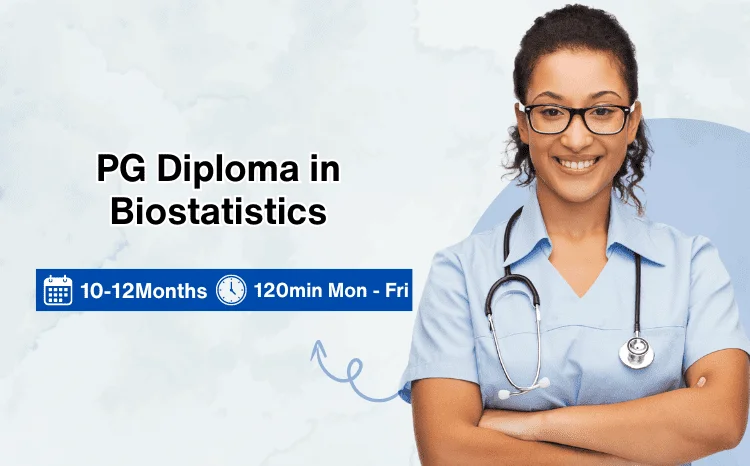
A PG diploma in Biostatistics course is a specialized program designed to equip students with statistical knowledge and develop computational skills. It is generally required to analyze biological and health-related data. This interdisciplinary field sits at the intersection of statistics, biology, and public health, making it important for evidence-based decision-making in the healthcare and pharmaceutical sectors.
The curriculum of PG Diploma in Biostatistics course covers fundamental statistical methods, experimental design, clinical trials, epidemiology, and statistical software (like R, SAS, or Python). You will be learning to interpret data from medical research, pharmaceutical studies, and public health initiatives. This program is ideal for graduates in statistics, mathematics, biology, medicine, pharmacy, or allied health sciences who wish to apply quantitative methods to solve real-world problems in health.
Why Clini Launch?
Industry Driven Curriculum
● Adapt to industry standards
● Gain in-depth knowledge
● Up to date your skill sets
Experienced Instructors
● Interact with seasoned professionals
● Insightful healthcare practices
● Dedicated industry experts
Hands-on Learning
● Live interactive session
● Integrated case studies
● Practical step guidance
Industry Recognized Accreditations
● International Accreditation Organization (IAO)
● International Accreditation Forum (IAF)
● National Skill Development Council (NSDC)
Career Support Services
● Access to Career support group
● Resume Building Workshops
● Placement Mentorship Program
What Sets CliniLaunch Apart

Placement Assistance
Strong network of recruiters from the healthcare, pharmaceutical, and biotechnology industries and offer placement assistance to students.
Industry Expert Trainers
Equip yourself with skills and knowledge under the mentorship of experienced faculties with over 17 years of experience in the field of healthcare research and training.
Learning Management System
Embark on a transformative learning experience with our state-of-the-art Learning Management System!
Non-Technical and Technical Sessions
Go beyond the textbook with a well-rounded foundation balancing essential technical and non-technical skills needed to thrive in healthcare, IT and Pharma.
Job Oriented Programs
Get comprehensive job-oriented programs to empower you with the skills and knowledge you need to succeed in the dynamic and competitive healthcare sector.
Eligibility Criteria for Biostatistics Course
Eligibility for a PG Diploma in Biostatistics typically requires a bachelor’s degree in a relevant science field (e.g., Life Sciences, Biotechnology, Pharmacy, Medicine, Statistics, Mathematics) with a minimum aggregate percentage. Clini Launch prefer candidates with a background in statistics or a related quantitative discipline. Specific institutes might have additional requirements or entrance exams.
Eligibility Criteria

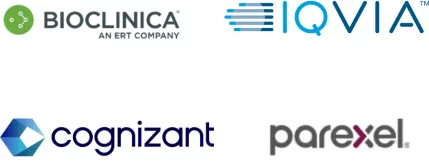
Aspire to become a Healthcare Analyst/Biostatistician?
Curriculum Designed by Healthcare Industry Experts
Curriculum Designed by Experts
Common Curriculum for Biostatistics classes online
This module provides a foundational understanding of biostatistics, covering the various
statistical methods commonly employed in biomedical research. It introduces essential
concepts and terminology, emphasizing the critical role of statistical analysis in healthcare
and clinical research for drawing valid conclusions and making informed decisions.
This module focuses on techniques for summarizing and presenting data. Students will
learn to calculate and interpret measures of central tendency (e.g., mean, median, mode)
and dispersion (e.g., standard deviation, range). It also covers various graphical and chart
based methods for visualizing data, enabling effective communication of data
characteristics.
Building on descriptive statistics, this module delves into methods for making inferences
about populations based on sample data. Key topics include understanding probability
distributions, conducting hypothesis tests to assess claims, and constructing confidence
intervals to estimate population parameters. Students will gain practical experience with
common statistical tests such as t-tests, ANOVA, and chi-square tests.
This module introduces powerful statistical techniques for modeling relationships
between variables. It starts with linear regression, exploring how to predict one variable
based on another. It then progresses to multiple regression, allowing for the analysis of
relationships with multiple predictor variables, and covers essential aspects of model
building, assessment of model fit, and interpretation of regression coefficients.
This module specializes in analyzing time-to-event data, commonly encountered in clinical
trials and public health. It covers the unique characteristics of survival data, including
censoring, and introduces methods like Kaplan-Meier survival curves for visualizing
survival probabilities. The module also explores the Cox proportional hazards model, a
widely used technique for identifying factors influencing survival.
This module provides a comprehensive overview of the principles and methodologies
behind clinical trials. It covers crucial aspects such as randomization and blinding to
minimize bias and discusses methods for determining appropriate sample sizes and
various study design considerations essential for conducting robust and ethical research.
This module introduces the fundamental concepts and study designs used in
epidemiology, the study of disease patterns in populations. It covers measures of disease
frequency (e.g., incidence, prevalence) and measures of association (e.g., relative risk,
odds ratio). The module also focuses on interpreting epidemiological data and critically
assessing causal relationships.
This module provides practical, hands-on experience with statistical software packages
commonly used in biostatistics, such as R or SAS. Students will learn essential data
manipulation techniques and gain practical experience in applying various biostatistical
methods using these software tools for real-world data analysis.
This module explores the practical application of biostatistics within various healthcare
contexts. It examines how biostatistical principles are used in healthcare policy and
management, for evaluating the effectiveness of healthcare interventions and outcomes,
and for analyzing real-world healthcare data to inform evidence-based decision-making.
This culminating module provides students with the opportunity to apply the biostatistical
methods learned throughout the curriculum to a practical research project. It involves
designing and executing statistical analyses, critically interpreting the results, and
effectively presenting their findings in a comprehensive manner.
FREE Career Counselling
We are happy to help you 24/7
A Student’s Journey



Industry-Ready Training
Equip yourself with skills and knowledge required to be successful in the healthcare-pharma or healthcare-IT industry. Enhance your communication and personality.
Certified Courses
Earn credentials through online or in-person programs validating the enhancement of your skills and expertise in the healthcare-IT and pharma sector.
Get Placed
Gain access to volunteer, internship, and placement opportunities and apply real-world applications in healthcare settings like hospitals, CROs, and pharma companies.
Level up your Career with a PG Diploma Biostatistics Course
Real people. Real results.
In-demand skills and Knowledge
Propel your career with Clini Launch’s healthcare Management program.

Potential Mentorship Advantage
Get personalized mentorship and support for your career choice.

Prepare for your Medical Career with Confidence
Upskill yourself for a rewarding career that you truly enjoy.

FAQs on Biostatistics Courses
The typical prerequisites for enrolling in a Biostatistics Course usually include a bachelor’s degree in a quantitative field such as Mathematics, Statistics, Computer Science, Public Health, or a life science discipline (e.g., Biology, Medicine, Pharmacy). A strong foundation in college-level algebra and basic statistics is essential.
A comprehensive PG Diploma in Biostatistics Course aims to equip students with the ability to:
- Design and conduct epidemiological and clinical studies with appropriate statistical considerations.
- Apply various statistical methods (e.g., hypothesis testing, regression analysis, ANOVA, survival analysis) to biological and health data.
- Utilize statistical software (e.g., R, SAS, SPSS, Stata) for data analysis and interpretation.
- Interpret and effectively communicate complex statistical results to both technical and non-technical audiences.
- Understand and address common biases and confounding factors in research.
After completing a Biostatistics Course, a wide range of career opportunities become available, including:
- Biostatistician: Working in pharmaceutical companies, CROs (Contract Research Organizations), academic research institutions, or government health agencies.
- Statistical Analyst: Supporting research teams in data analysis and reporting.
- Clinical Data Manager: Focusing on the integrity and quality of clinical trial data.
- Epidemiologist: Analyzing public health data to study disease patterns.
- Public Health Analyst: Working on health policy and program evaluation.
A Biostatistics Course integrates theoretical knowledge with practical applications through:
- Lectures on statistical theory, probability, and hypothesis testing.
- Hands-on labs where students apply statistical methods using software like R or SAS to real-world datasets.
- Case studies from epidemiological studies, clinical trials, and public health initiatives.
- Project-based assignments that require students to design studies, analyze data, and interpret results, often culminating in a research paper or presentation.
While Biostatistics shares core principles with general statistics, its primary difference lies in its application domain. Biostatistics specifically focuses on the application of statistical methods to biological, medical, and public health data. This includes handling unique challenges like survival data, correlated data from longitudinal studies, and the complexities of clinical trials and observational studies, which require specialized statistical approaches.
Following are the key areas within Biostatistics that are critical for modern healthcare research include:
- Clinical Trials Design and Analysis: Ensuring robust methodology for drug and treatment efficacy.
- Epidemiology: Studying disease patterns, causes, and control in populations.
- Genomics and Proteomics: Analyzing high-dimensional biological data.
- Survival Analysis: For time-to-event data in disease prognosis and treatment.
- Longitudinal Data Analysis: For repeated measurements on individuals over time.
- Statistical Genetics: Investigating the genetic basis of diseases.
Biostatistics is fundamental to evidence-based medicine by following:
- Design clinical trials to generate reliable evidence on treatment efficacy and safety.
- Analyze trial data objectively to draw valid conclusions about interventions.
- Quantifying uncertainty around research findings.
- Synthesizing evidence from multiple studies through meta-analysis.
- Providing the statistical foundation for guidelines and recommendations that inform clinical practice.
Following are the data types that are commonly handled in Biostatistics include:
- Categorical data (e.g., disease presence/absence, blood type).
- Numerical data (e.g., blood pressure, age).
- Time-to-event data (e.g., time to recovery, survival time), which presents challenges due to censoring.
- Longitudinal data (repeated measurements on the same individual), requiring methods for correlated data.
- High-dimensional “omics” data (genomics, proteomics), which poses challenges for managing large variables and small sample sizes.
- Missing data, a common issue requiring specific imputation techniques.
Following are the advantages of taking biostatistics classes online for aspiring professionals include:
- Flexibility: Ability to learn at one’s own pace and schedule, ideal for those with existing work commitments.
- Accessibility: Enroll in programs from top universities or institutes globally, regardless of geographical location.
- Cost-effectiveness: Often lower tuition fees compared to on-campus programs, plus savings on commuting and living expenses.
- Recorded sessions: Opportunity to revisit lectures and content anytime for better understanding and revision.
Biostatistics Classes online ensure hands-on practice with statistical software by:
- Providing access to cloud-based statistical software platforms (e.g., RStudio Cloud, SAS OnDemand).
- Guiding students on installing free software like R and RStudio locally.
- Integrating downloadable datasets for practice exercises and assignments.
- Offering interactive coding exercises and virtual lab sessions where students can apply learned concepts directly.
Technical support for students in Biostatistics Classes online typically includes:
- Dedicated helpdesks or email support for software installation and troubleshooting.
- Online discussion forums or community groups where students can post questions and receive assistance from instructors or peers.
- Scheduled virtual office hours or Q&A sessions with instructors.
- Comprehensive documentation and troubleshooting guides for common issues.
For a smooth experience with biostatistics classes online, specific requirements generally include:
- A stable, high-speed internet connection (broadband recommended for live sessions and large data downloads).
- A modern computer (laptop or desktop) with sufficient RAM (8GB or more is ideal) and processing power to run statistical software.
- A functional webcam and microphone for interactive sessions.
- An updated web browser and potentially specific client software for accessing virtual learning environments.
A Biostatistics Certificate Course adds significant value to a life science or healthcare professional’s resume by:
- Bridging the gap between domain knowledge and statistical analytical skills, making them more competitive.
- Validating specialized skills in data analysis, interpretation, and research methodology.
- Enhancing career mobility into roles requiring quantitative expertise in pharma, public health, or clinical research.
- Demonstrating a commitment to professional development and data-driven decision-making.
A Biostatistics Certificate Course commonly includes projects or assignments such as:
- Analyzing publicly available health datasets (e.g., from NHANES, CDC).
- Designing a mock study and developing a statistical analysis plan.
- Performing regression analysis on patient outcome data.
- Interpreting results from clinical trials and presenting findings.
- Writing short reports summarizing statistical analyses.
- Implementing specific statistical tests using software for real-world scenarios.
The duration of PG Diploma in Biostatistics at Clini Launch is one year including 2 months of internship opportunities for your career growth and advancements. As it is a more comprehensive program the course may Strech up to 2 months more.
Yes, PG Diploma in biostatistics course from Clini Launch serves as a valuable steppingstone to a master’s degree in biostatistics. While this course might not grant direct credit for all master’s course relevant to biostatistics. The certification for biostatistics demonstrates a strong foundational understanding and commitment to the field. It can significantly strengthen an application, particularly if the certificate program is offered by Clini Launch.
Pursuing a biostatistics online certificate from Clini Launch offers several advantages:
- Credibility: You need to check whether the institute adds a significant weight to your resume. This indicates a high standard of academic rigor.
- Experienced Faculty: Access to industry experts with strong research backgrounds and expertise.
- Structured Curriculum: Well-designed biostatistics online program that builds knowledge and skills progressively.
- Access to valuable resources: Libraries, databases, and potentiall career services such as placement assistance.
A Biostatistics Online Certificate prepares individuals for roles in CROs by:
- Teaching the statistical methodologies used in clinical trial design and analysis.
- Providing hands-on experience with statistical software commonly used in CROs (e.g., SAS, R).
- Introducing concepts of regulatory guidelines (e.g., ICH-GCP) and data standards.
- Developing the ability to interpret and present results from clinical studies, a core function in CROs.
In a biostatistics online certificate program, peer-to-peer interaction and networking opportunities are often fostered through:
- Online discussion forums or dedicated communication platforms (Learning Management System).
- Group projects and collaborative assignments.
- Live virtual classroom sessions that encourage Q&A and active participation.
- Virtual networking events or guest speaker series where students can connect with professionals.
- Alumni groups facilitated by Clini Launch.
Assessments and evaluations in a biostatistics online certificate programs are conducted through:
- Online quizzes and exams (often timed and protected).
- Homework assignments involving statistical problem-solving and software application.
- Project-based assignments where students analyze datasets and present findings.
- Participating in online discussions or critiques.
- A final comprehensive project or exam to demonstrate overall mastery.
The main differences in focus between Biostatistics Certificate Programs and those in Data Science or Analytics are:
- Biostatistics: Primarily focuses on statistical inference and methodology for biological, health, and clinical data, with a strong emphasis on causality, study design, and regulatory compliance in medical research.
- Data Science/Analytics: Broader in scope, applying statistical, computational, and domain knowledge to various industries. It often emphasizes predictive modeling, machine learning, and working with diverse data types (e.g., web data, financial data).
While the specific mix can vary, the software tools Clini Launch taught across biostatistics certificate programs are:
- R (with RStudio): This is the highly popular tools for statistical computing, graphics, and its vast ecosystem of packages.
- SAS: It is widely used in the pharmaceutical industry and clinical research for its robust data management and statistical analysis, and acceptance of regulatory bodies.
- Less common but relevant: Stata or SPSS, especially in public health research.
In Biostatistics Certificate Programs, students can generally expect:
- Regular interaction with instructors during live sessions, Q&A forums, or virtual office hours.
- Feedback on assignments and projects from faculty or teaching assistants.
- Opportunities for one-on-one guidance on specific concepts or project challenges.
- Some programs may offer structured mentorship from senior students or industry professionals, though this is more common in longer degree programs.
Biostatistics Certificate Programs address the nature of data and analytical techniques by:
- Regularly updating their curriculum to include new methodologies and software features.
- Incorporating modules on emerging topics like big data biostatistics, machine learning in clinical research, or genomic data analysis.
- Encouraging the use of up-to-date software versions and libraries.
- Inviting guest speakers from industry or academia to discuss current trends and research.
An Introduction to Biostatistics course typically covers core concepts such as:
- Types of data and variables in health research.
- Measures of central tendency and dispersion (mean, median, mode, standard deviation).
- Probability and probability distributions (e.g., normal distribution).
- Sampling and sampling distributions.
- Hypothesis testing: t-tests, chi-square tests, ANOVA.
- Correlation and basic linear regression.
- Interpretation of p-values and confidence intervals.
An Introduction to Biostatistics course can be suitable for individuals with a non-science background, particularly if it’s designed with minimal prerequisites. However, a basic understanding of mathematics (algebra) and logical reasoning is generally helpful. Many such introductory courses focus on conceptual understanding and interpretation rather than complex mathematical derivations.
The main goal of learning basic statistical concepts in an Introduction to Biostatistics course is to empower students to:
- Critically evaluate research literature in health and medicine.
- Understand the statistical methods used in published studies.
- Design simple studies and analyze basic health data.
- Communicate effectively with statisticians and researchers.
- Make informed decisions based on data-driven evidence in healthcare or public health contexts.
In an Introduction to Biostatistics course, the emphasis is typically more on practical application and interpretation of results rather than deep dives into mathematical formulas. While fundamental formulas are introduced to build conceptual understanding, the focus is on how to apply statistical tests, interpret their outputs from software, and draw meaningful conclusions from biological and health data.
The main benefits of pursuing a Graduate Certificate in Biostatistics Online for career advancement include:
- Specialized skill development: Acquiring advanced biostatistical expertise highly valued in research and industry.
- Enhanced credibility: Earning a university-level credential without the full commitment of a master’s degree.
- Career transition: Providing a structured pathway for professionals from related fields to enter biostatistics roles.
- Flexible learning: Allows working professionals to upskill while maintaining their current employment.
- Potential for master’s credit: Credits earned may often be transferable towards a Master’s in Biostatistics or Public Health.
A Graduate Certificate in Biostatistics Online typically covers advanced statistical topics such as:
- Regression models: Multiple linear regression, logistic regression, Poisson regression.
- Survival analysis: Kaplan-Meier, Cox proportional hazards models.
- Longitudinal data analysis: Mixed models, GEE (Generalized Estimating Equations).
- Clinical trial methodology: Advanced design principles, sample size calculations.
- Epidemiological methods: Advanced study designs, confounding, interaction.
- Introduction to statistical programming in R or SAS at an advanced level.
A graduate certificate in biostatistics online differs from an M.S. (Master of Science) or M.P.H. (Master of Public Health) with a biostatistics specialization primarily in:
- Duration: Certificates are shorter (typically 1 year or less) compared to 2-year master’s programs.
- Depth and breadth: Certificates offer focused, specialized training, while master’s degrees provide a more comprehensive and theoretical foundation, often including a thesis or capstone project.
- Credit hours: Certificates require fewer credit hours.
- Career scope: While certificates enhance specific skills, master’s degrees generally open doors to a wider range of advanced and leadership roles.
A graduate certificate in biostatistics online can be sufficient for some entry-level Biostatistician or Statistical Programmer roles in the pharmaceutical industry, particularly if combined with a strong quantitative undergraduate background and relevant practical experience (e.g., internships). Many roles, especially at higher levels or those involving complex study design, often prefer candidates with a Master’s or Ph.D. in Biostatistics, but a certificate significantly strengthens your profile.
The fundamental importance of Biostatistics in designing robust clinical trials lies in ensuring that:
- Study objectives are clearly defined and measurable.
- Appropriate sample sizes are determined to detect clinically meaningful effects.
- Randomization methods are correctly applied to minimize bias.
- Statistical analysis plans are developed before data collection to avoid post-hoc bias.
- Confounding variables are identified and addressed through design or analysis.
- The trial results can be statistically sound and ethically conducted.
Biostatistics contributes immensely to public health policy and decision-making by:
- Analyzing population health data to identify disease trends, risk factors, and health disparities.
- Evaluating the effectiveness of public health interventions and programs.
- Forecasting disease outbreaks and informing resource allocation.
- Providing evidence-based insights to guide policy development for disease prevention and health promotion.
- Assessing the impact of environmental factors on population health.
Biostatistics is critical for interpreting research findings and avoiding misleading conclusions in several ways:
- Quantifying uncertainty: Providing confidence intervals and p-values to understand the precision and statistical significance of results.
- Controlling bias and confounding: Using statistical methods to adjust for factors that could distort associations.
- Identifying genuine effects: Distinguishing between real relationships and those that could arise by chance.
- Assessing generalizability: Understanding the limitations of study findings and their applicability to broader populations.
- Guiding proper graphical and tabular presentation of data to ensure clarity and avoid misrepresentation.
The importance of Biostatistics in the development and approval process of new drugs is paramount:
- Phase I-III Clinical Trials: Biostatisticians design trials, determine sample sizes, analyze safety and efficacy data, and prepare statistical reports.
- Regulatory Submissions: They are crucial for preparing statistical sections of regulatory submissions to agencies like the FDA, ensuring data integrity and compliance.
- Drug Safety Monitoring: They analyze post-market surveillance data to detect adverse events.
- Dose-Finding Studies: Determining optimal dosages based on statistical models.
- Ensuring Rigor: Their expertise ensures the scientific rigor and validity of claims made about new drugs, directly impacting patient safety and public health.
For a Biostatistician today, the most essential programming languages and software are:
- R: Widely used for statistical analysis, graphics, and developing new statistical methods, with a vast open-source ecosystem.
- SAS: The industry standard in the pharmaceutical and clinical research sectors for its robust data management capabilities and regulatory acceptance.
- Less frequently but still relevant: Python (for machine learning integration), Stata, and SPSS for specific applications or older projects.
A Biostatistician collaborates extensively with other professionals in a research team, including:
- Clinicians/Researchers: Advising on study design, sample size, and interpreting clinical relevance of statistical findings.
- Data Managers: Ensuring data quality, structure, and integrity.
- Medical Writers: Assisting in preparing statistical sections of publications and reports.
- Regulatory Affairs Specialists: Ensuring compliance of data analysis and reporting with regulatory guidelines.
- Epidemiologists: Collaborating on observational study designs and causal inference.
A Biostatistician holds significant ethical responsibilities in research, including:
- Ensuring objectivity and integrity in data analysis and reporting, avoiding manipulation of results.
- Protecting patient privacy and confidentiality when handling sensitive health data.
- Promoting transparency in study design, statistical methods, and results.
- Identifying and disclosing potential conflicts of interest.
- Ensuring statistical methods are appropriate for the research question and not misleading.
- Contributing to the ethical conduct of clinical trials through sound design and analysis.
Emerging trends and future directions in the field of Biostatistics include:
- Big Data Biostatistics: Handling massive and complex datasets (e.g., electronic health records, genomic data).
- Machine Learning and Artificial Intelligence: Integrating AI/ML techniques for prediction, classification, and pattern recognition in health data.
- Precision Medicine: Developing statistical methods for personalized treatment approaches.
- Causal Inference: Advancements in methods to establish causation from observational data.
- Bayesian Statistics: Increasing application in clinical trials and complex modeling.
- Real-World Evidence (RWE): Utilizing real-world data sources for regulatory decisions.
- Data Visualization and Communication: Enhancing ways to present complex statistical results clearly.
CliniLaunch recent placed students
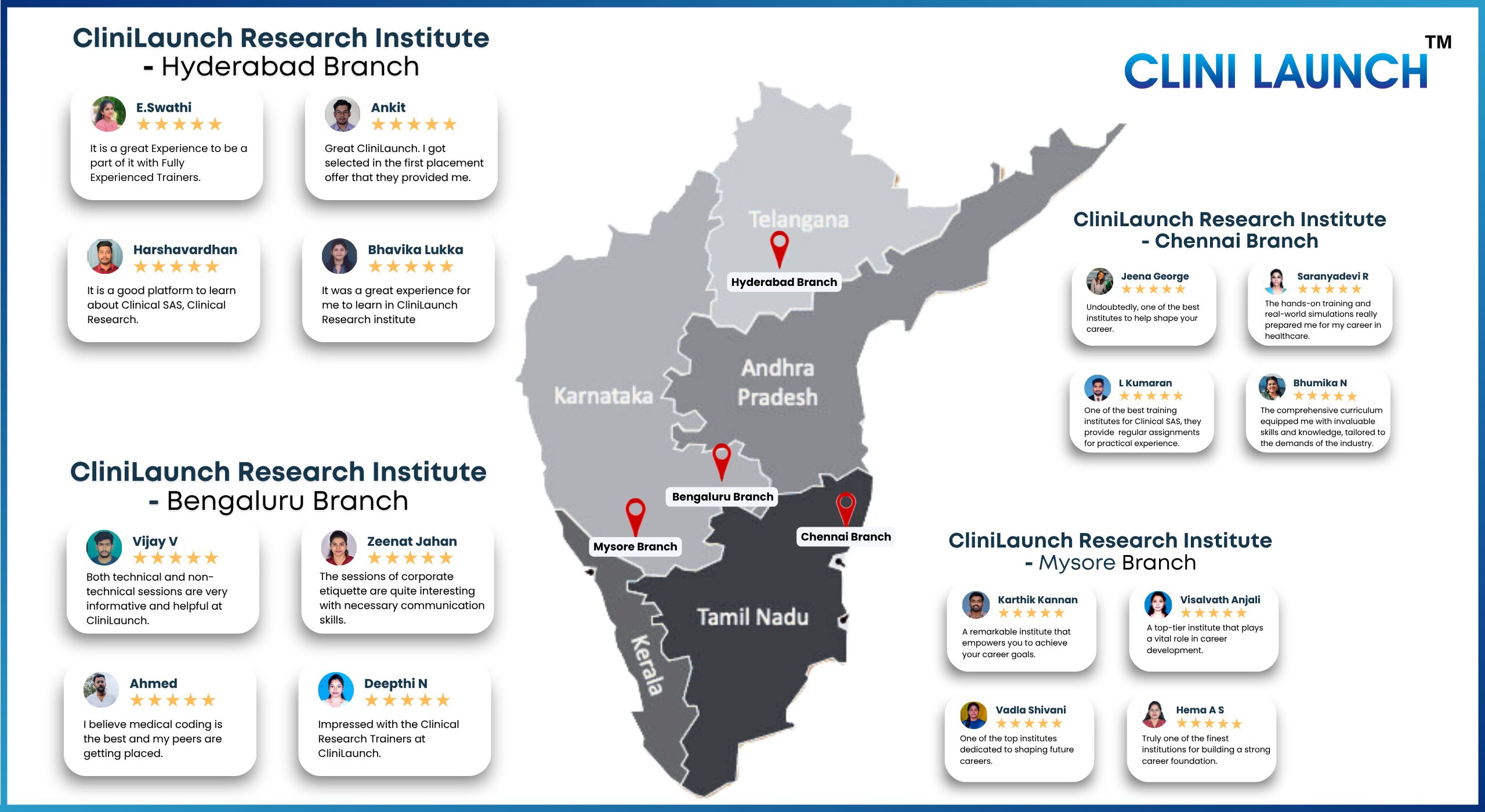
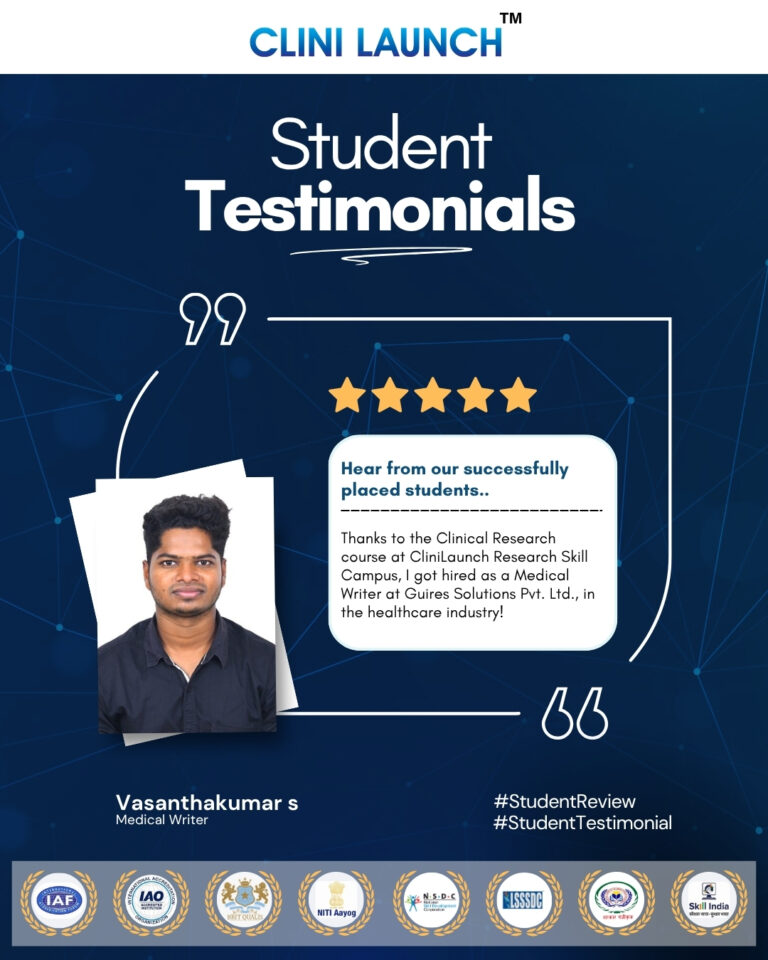
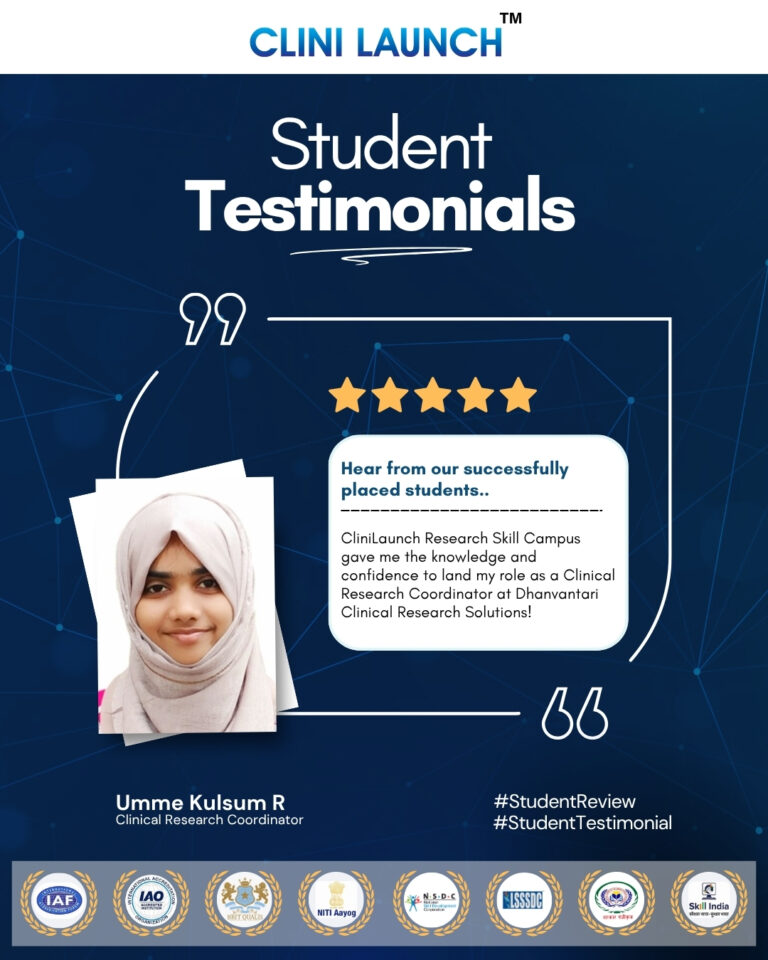



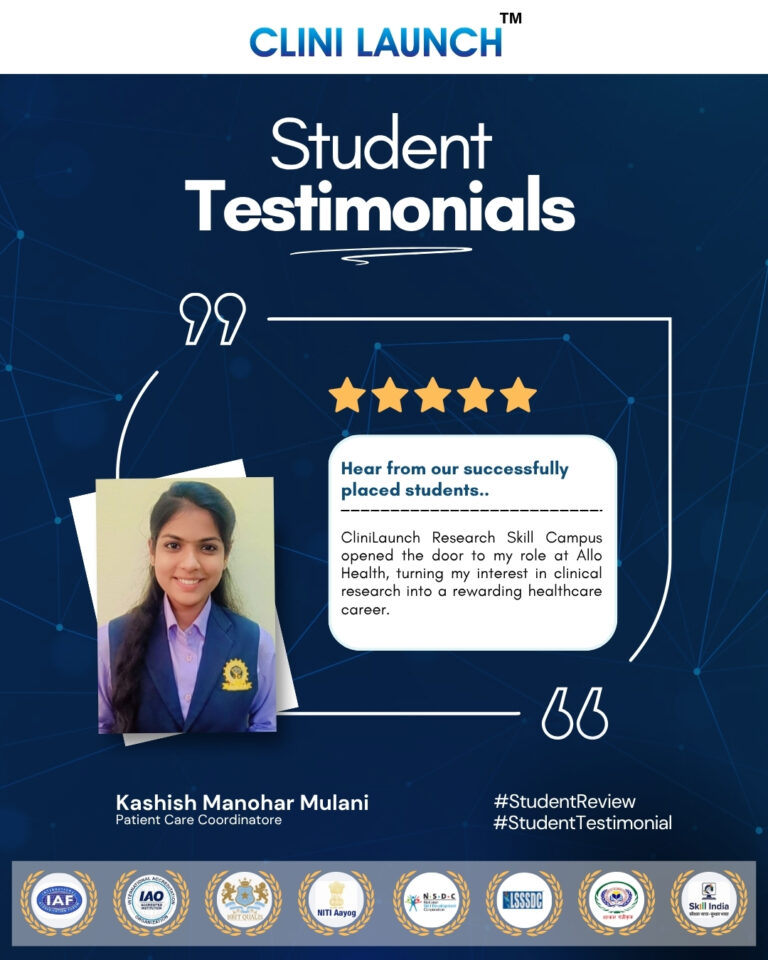

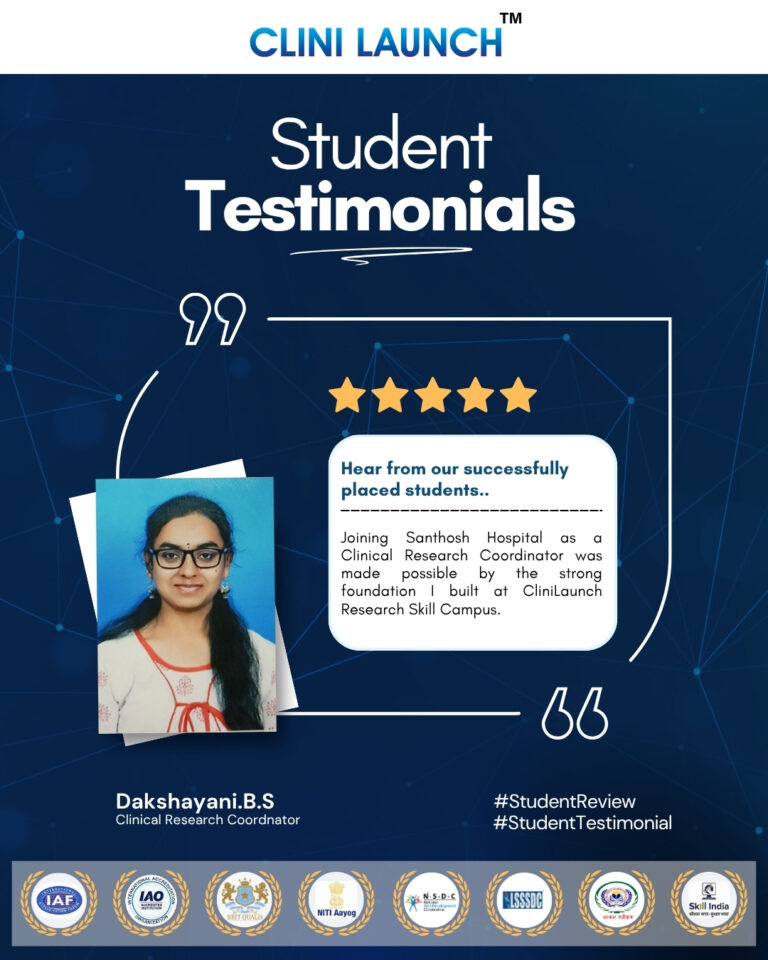
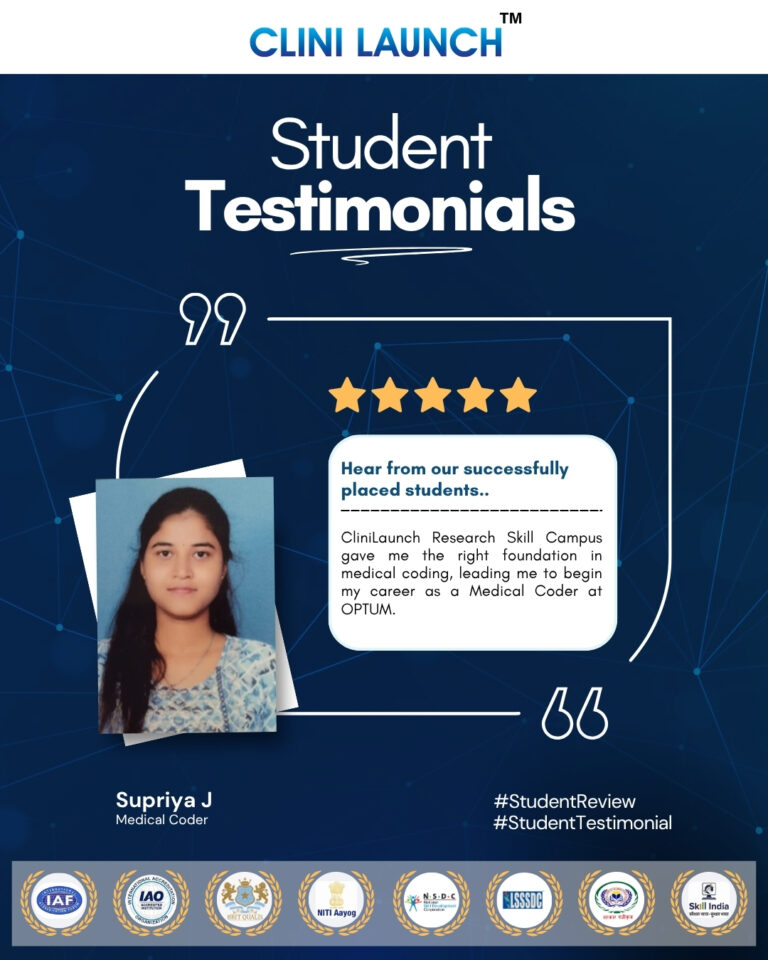
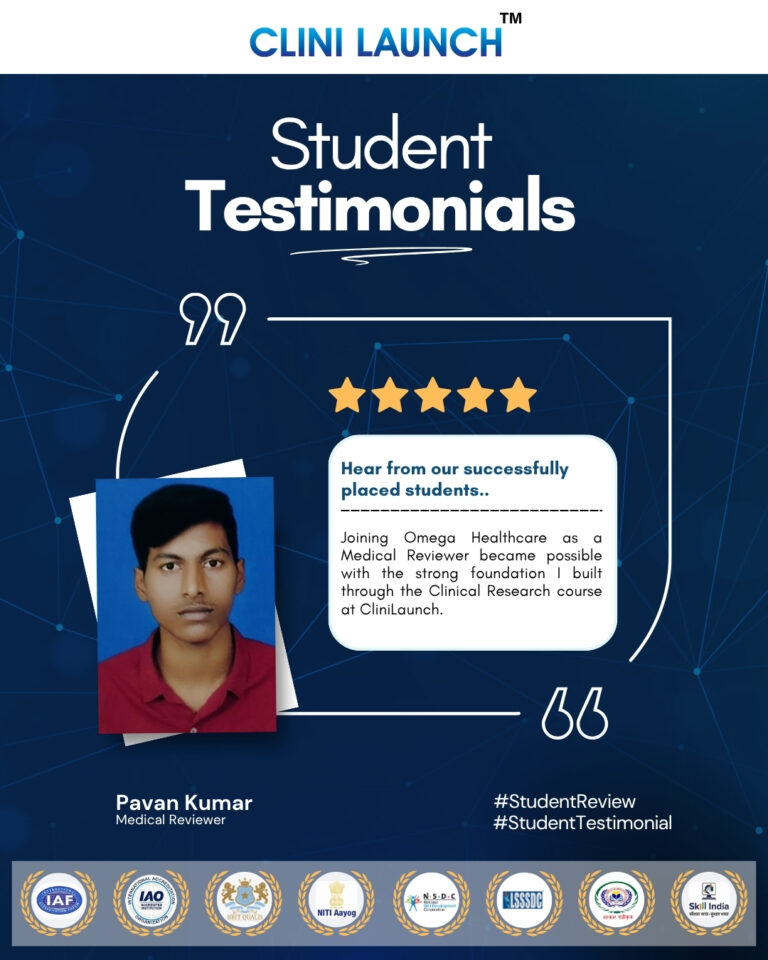
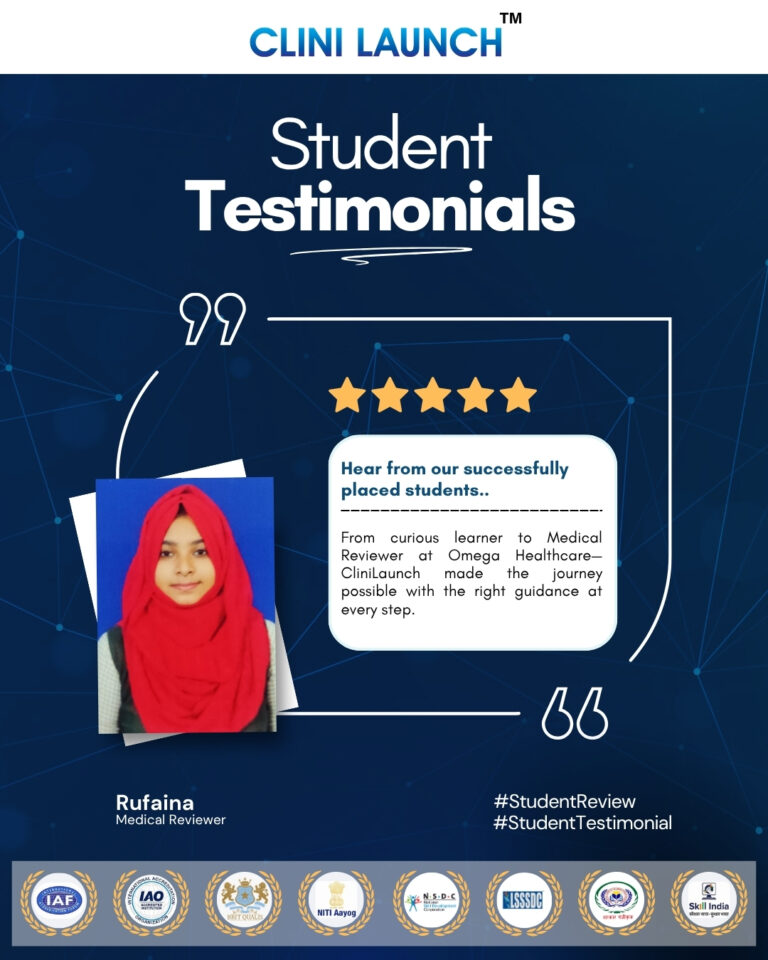
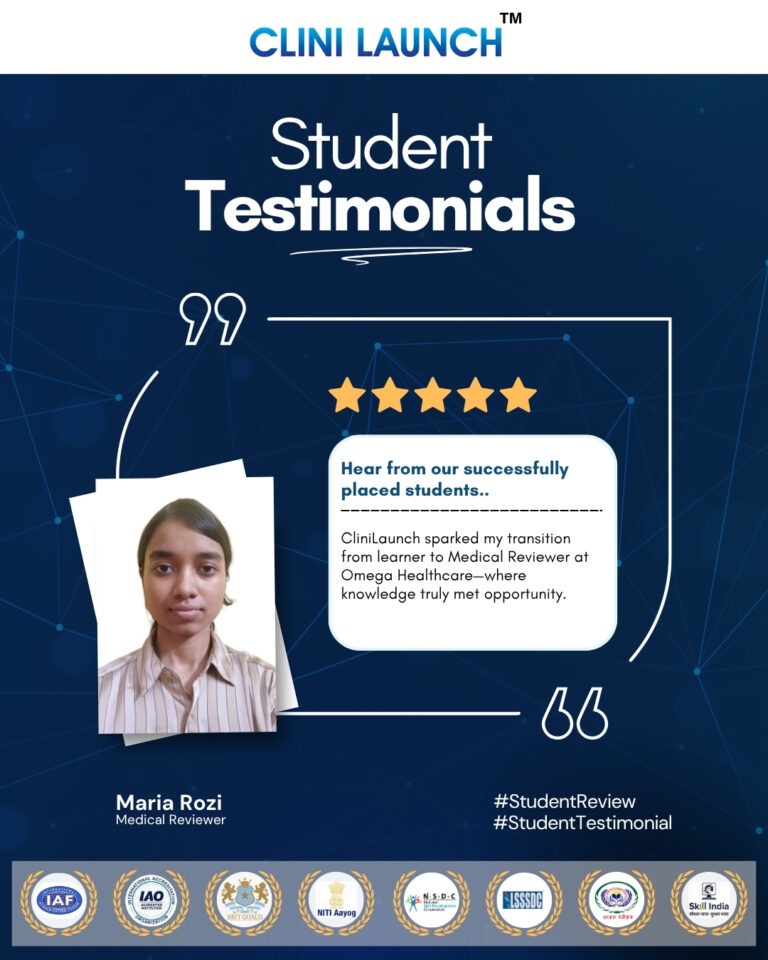
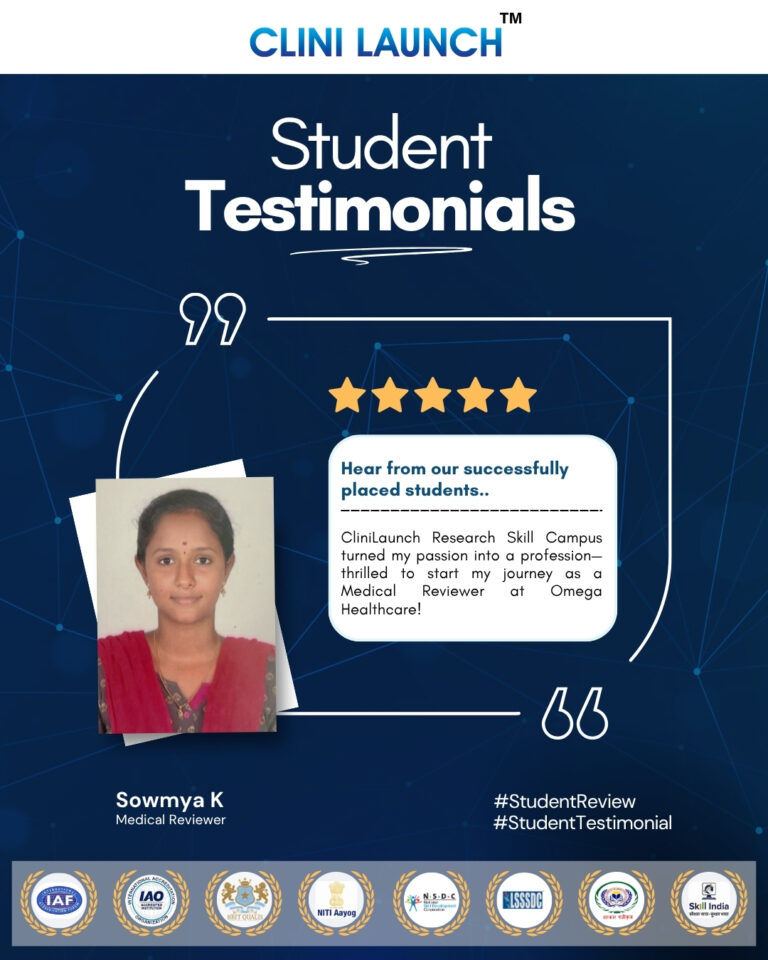
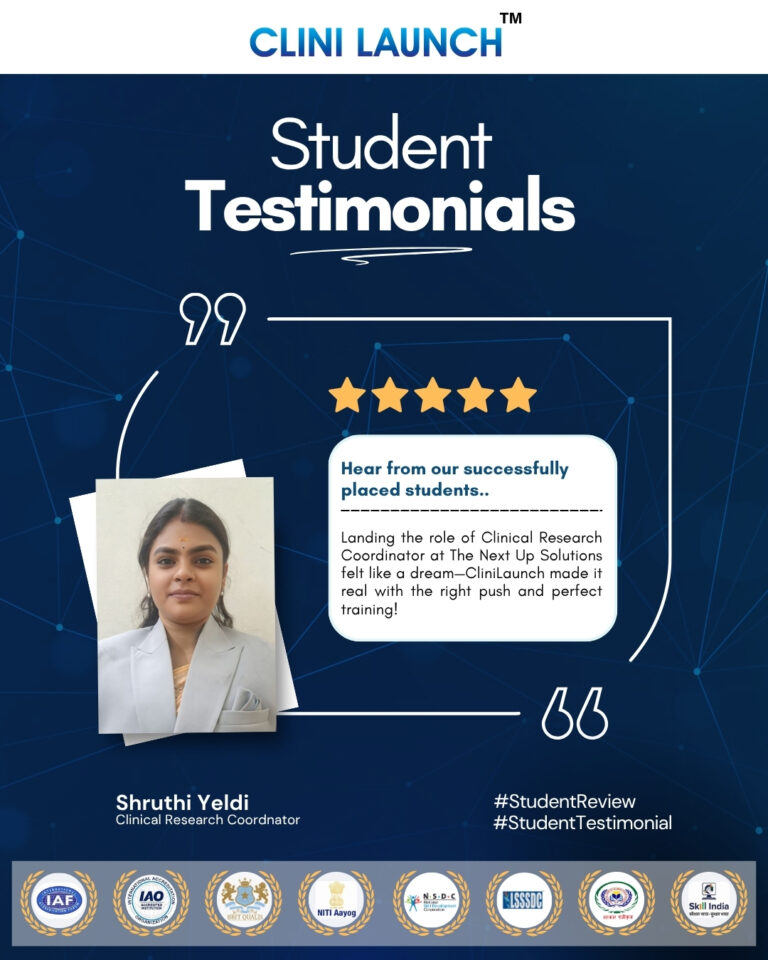

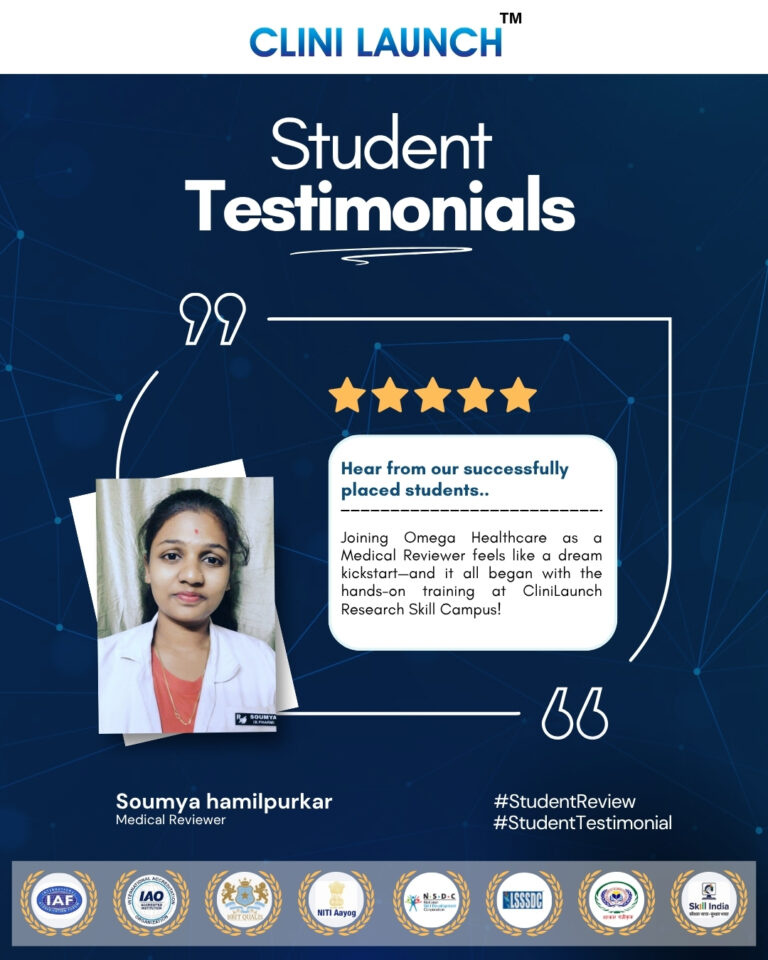
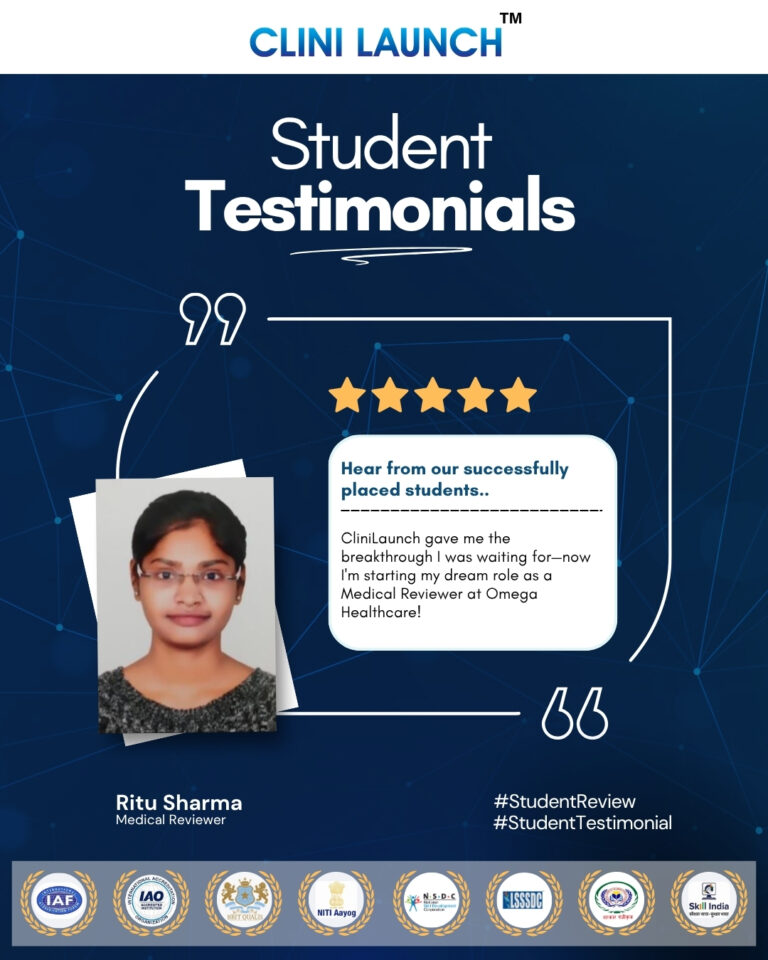


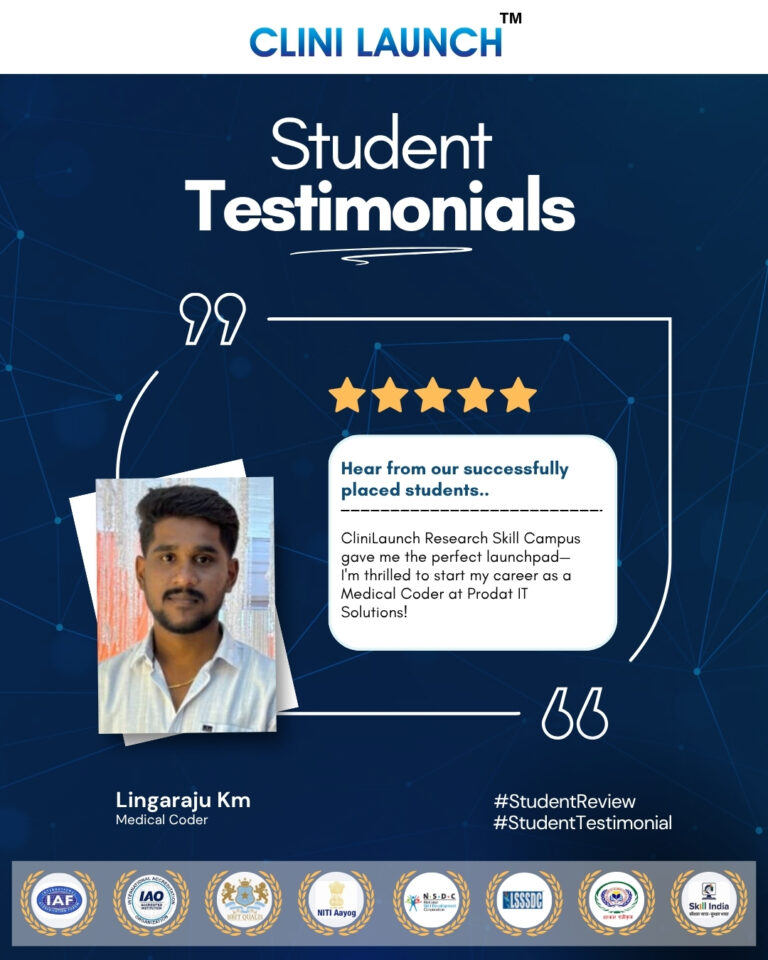
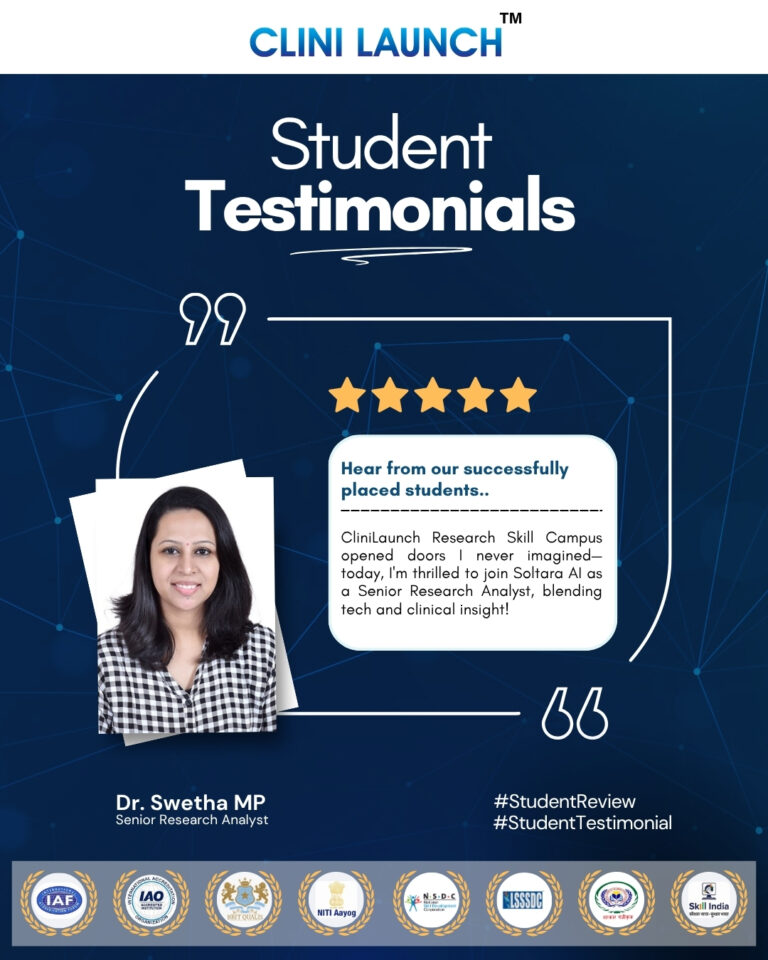
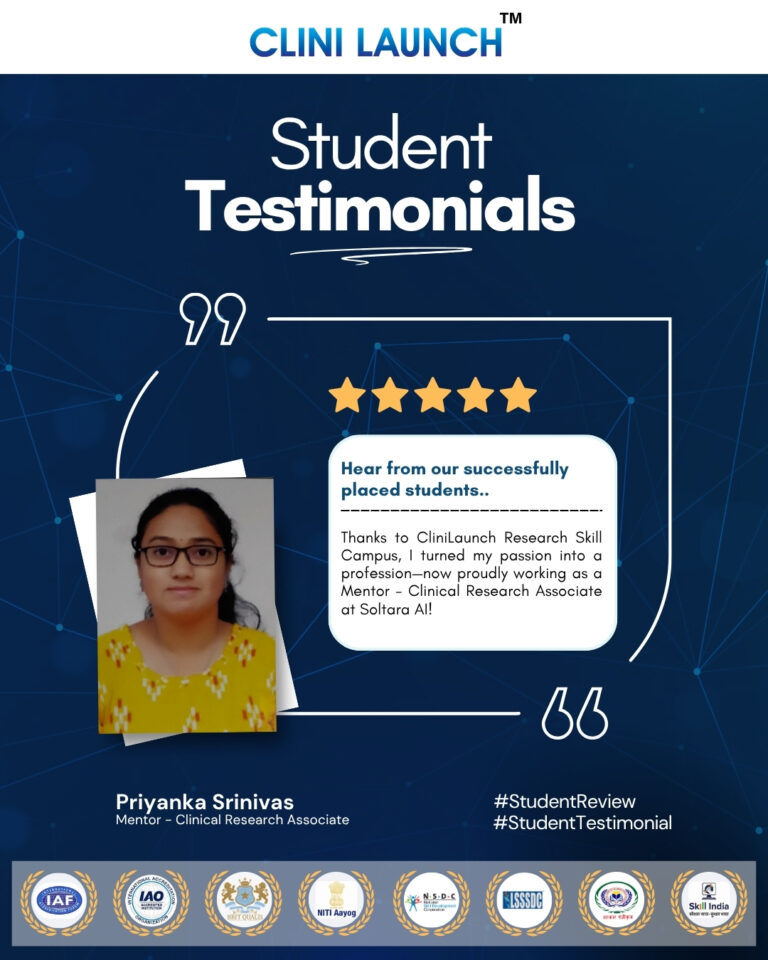


Testimonials
Upskilling does make a difference. Graduates speak out.Hear what our students and professionals are saying about their upskilling journey with CliniLaunch.

